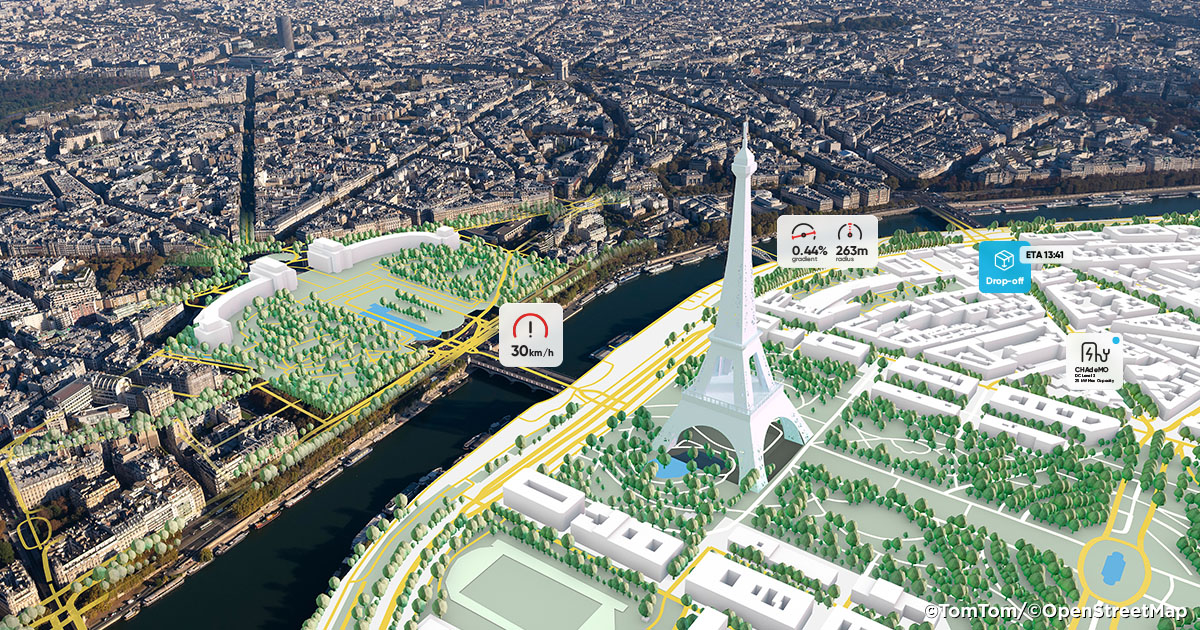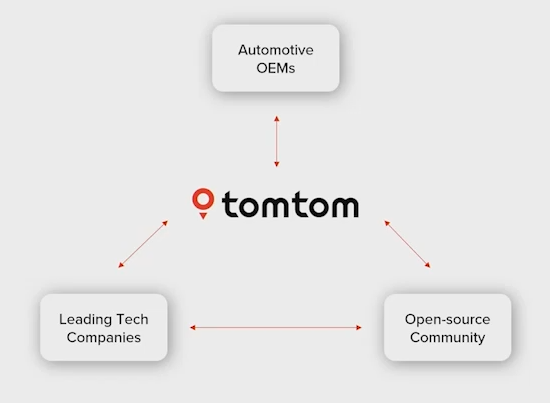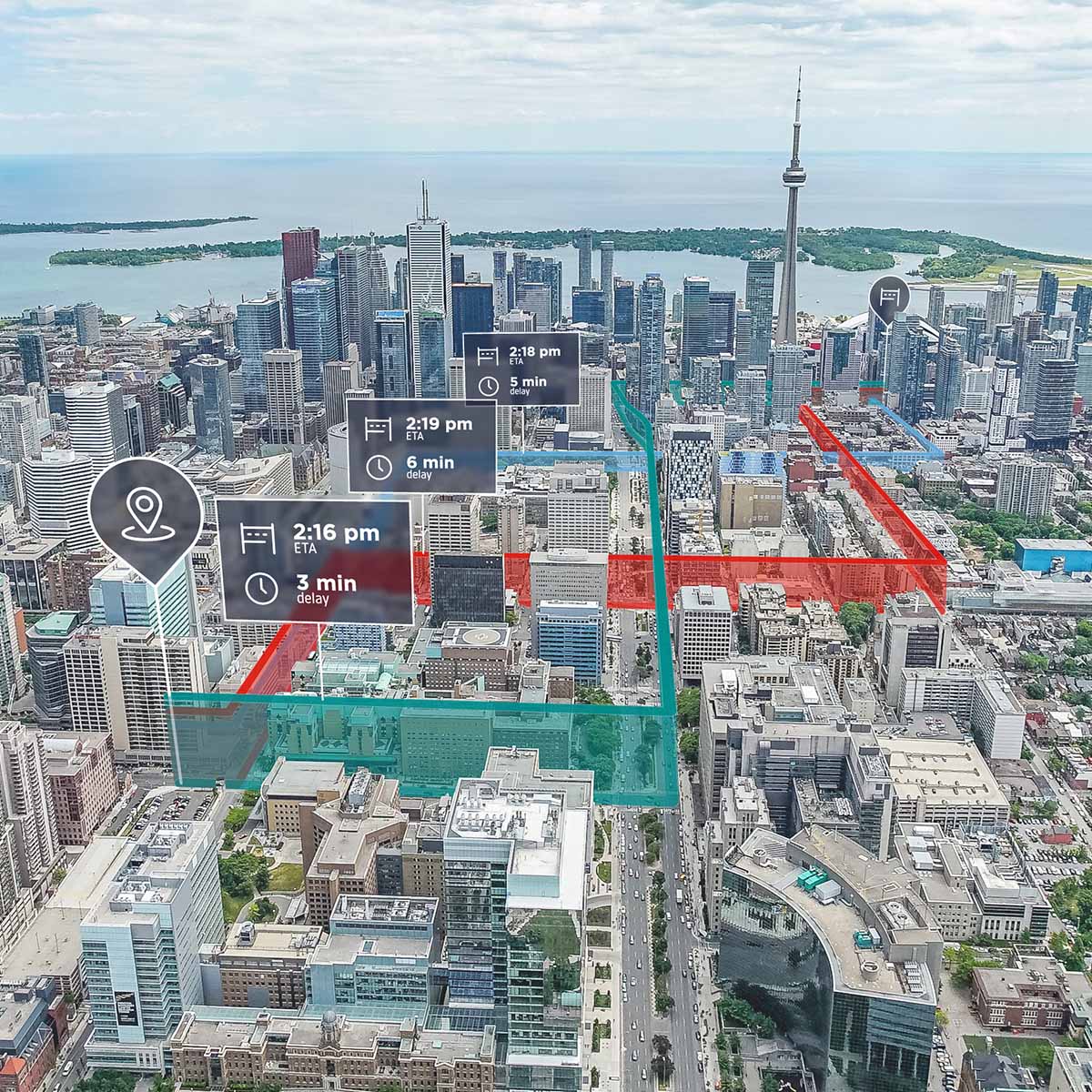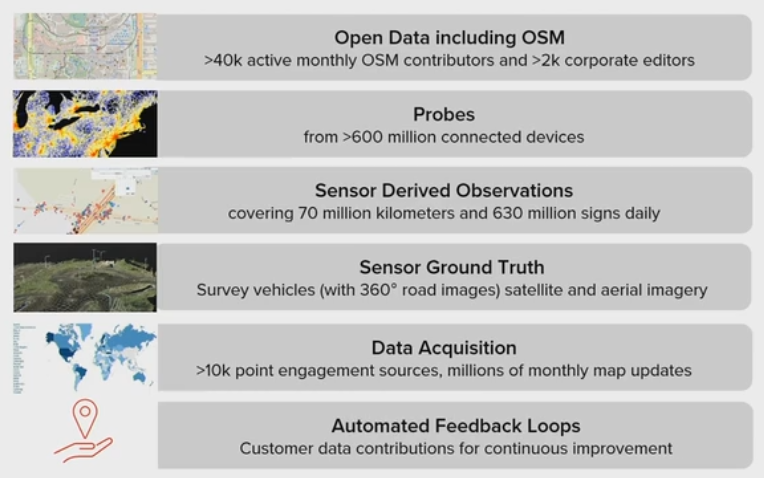“In time, those Unconscionable Maps no longer satisfied, and the Cartographers Guilds struck a Map of the Empire whose size was that of the Empire, and which coincided point for point with it.” - Borges*
TomTom has taken a mighty bruising over the years. Smartphones ate the satnav company’s lunch in the noughties and its share price tanked from €95 to €5 between late 2007 and early 2009 as the financial crisis hit.
The Dutch company has persevered, making its money from not just devices (it has over 600 million connected devices out there contributing to location data) but increasingly from licensing its maps and real-time traffic data, as well as associated software services including software libraries for vehicles’ “digital cockpits”.
(TomTom says it ingests up to six billion GPS probes per day and five billion kilometres of live trip data; it provides real-time traffic information in 79 countries and its global SD Map covers over 74 million kilometres of roads. Its platform also provides EV charging point and weather data, on-street and off-street parking data and more.)
The September 2022 news that it had clinched Hyundai Motor Group as a client (all Hyundai and Kia cars sold in Europe will ship with maps and real-time traffic data from TomTom) was a significant lift for TomTom.
But with free cash flow expected to be negative in 2022 and investor appetite for unprofitable companies increasingly strained (TomTom’s Q3 results showed it trimming quarterly losses from €23 million to €18 million and growing revenues 7% to €136 million) TomTom has long-needed a strategic shakeup.
As CTO Eric Bowman put it at an investor day on November 3: "We measured and bought millions of data points: Road geometry, address points, points of interest, museums, hospitals; the cornershop. We conflated and fused and shaped and chiselled all that data to an amazing product that really did change the world. [TomTom's first satnav in 2004 become one of the fastest selling consumer technology devices ever.] But the cost of doing that, not just for us, but for every map-maker, has become a significant constraint and really unsustainable."
TomTom 2.0: New map, new partners, new ideas

TomTom is gearing up to take a very new approach.
At an investor day earlier this month the founder-led company promised a new map, mapping platform and ecosystem. This will marry its own data together with data from new “super sources” including from vehicles themselves, other partners and open-source projects, such as OpenStreetMap. It will also revamp its APIs and SDKs for customers as part of a renaissance that co-founder and CMO Corinne Vigreux dubs “TomTom 2.0.”
It now wants to do more than sell a service. It wants to power new ones -- like self-driving vehicles.
The company is “trying to create an open data solution and wants to co-collaborate with some of the biggest companies in the industry to do so” says Michael Harrell, VP Software Engineering TomTom Maps.

Existing rival products, he says, are inflexible and despite some opening, users don't get to truly control the prioritisation of features, it's exceptionally difficult to layer in your own data, ultimately the product remains proprietary.
The new TomTom Maps Platform (due to launch in Q2, 2023) will see it take more collaborative approach to working with automotive and other partners than rivals like Google Maps; something that TomTom hopes will make it an increasingly sought-after partner. With "location-based data" from its automotive segment generating the larger share of its revenue, it's also looking to innovate more in the space, including by collaborating with OEMs to license them data that can enhance their self-driving capabilities.
Follow The Stack on LinkedIn
One key input for this will come from vehicles themselves -- and not just things like GPS.
TomTom Chief Technology Officer (CTO) Eric Bowman, speaking with The Stack, notes that as work continues on driver assistance technology and “software-defined vehicles”, that they are getting loaded with cameras.
But, as he notes on a November 7 call: “Cameras are not sufficient. The real safety wins come from a richer understanding of what is not visible; what's coming up, what's around the corner. For EVs especially [that includes], how steep is it, the weather conditions, what turns are coming and how to prepare.
He adds: "Basically, these cameras are doing a lot of image processing onboard and essentially tagging the data for the benefit of ADAS [Advanced Driver Assistance Systems] applications… in partnership with OEMs, we're able to access this data in real time, and in a very privacy sensitive way. But we're able to see it in aggregate. So we begin to have a much richer view of where lanes are, what the signs are, but also when there are real time hazards... we've taken a major technical step forward there over the past couple years.
The TomTom CTO adds: “None of this was available even three years ago, because it's expensive to get data on and off the car. So that [data] tagging is very efficient in terms of bandwidth and very information rich. And OEMs have a strong motivation to cooperate around it. It's for mutual benefit…”
New TomTom Maps Platform

A big focus when it comes to the new TomTom Maps Platform is “opening our technology to others to layer their own data against a consistent base map, which can easily be integrated” as the company puts it.
TomTom CTO Eric Bowman tells The Stack: “Our biggest and most technically savvy customers are very interested in participating in the map creation process… they may use our system to do computational work on the map, which they are prepared to donate in some form of open data, whether it's OSM directly, and under ODbL, or other open licences’ especially companies for whom that data is not core to their business.”
“One of the challenges that that OSM [OpenStreetMap] faces is that it is not particularly compute-friendly. In general, one of the challenges of working with it, is that if you want to make a large data contribution back, it's extraordinarily difficult to schedule the work of getting that data into OpenStreetMap because you have to go and negotiate with 40 different communities... It's difficult to predict [how fast it will happen] and it's [OSM] not really open to the idea of using software, or using automation to do it. So, for those companies that want to interact with [maps], we have a much more automated approach to make contributions to open data…”
He adds: “[Another option for customers] is for companies that might wish to incorporate their data directly into the map, but they don't actually wish to share it. So a ride sharing company might have a bunch of pickup and drop off point locations, which they consider commercially sensitive. Today, they might buy a map from us or one of our competitors, or they might use Google's online services. Somehow they’ve [then] got to figure out how to get those points into the map somehow, include them in their routing algorithms, search etc. and it's actually kind of onerous.

Through our open platform approach, they [will] have a much easier way to do that; they can incorporate it into the map using our tooling and automation solutions. Then when they get a map product from us, it's already in the map [as a private layer] that we would not include that in the map that we sell to others."
What's it built on?
The application is cloud-neutral but TomTom's a big Azure partner, the CTO says.
He adds: "Conceptually, the way [the new platform build] works is that there is a serial component to the map production process, which involves linear sequence of steps. That is mostly around establishing the different base maps that can exist; where base map could be the road network, or it could be biking trails, or it could be railways. There are different base maps as you can imagine, but this kind of core graph.
"We use quite a interesting trick, which is the idea of a logical clock, which allows us to then parallelize work and then combine that parallel workstream into a binding process, which without the logical clock would be intractable and with a logical clock becomes tractable. What we found is that it is so tractable, that we cannot see a limit on how many different parallel layers we could, we could produce. So it really is like map making machine."
The shift to this new TomTom Maps Platform and the companies overall evolution must have involved some significant organisational rethinking too, The Stack suggests. TomTom has over 4,400 staff globally but for all the talk of automation Bowman does not sound like he's gearing up for big cuts: "It is important to realise that a lot of what is required to make a great commercial-grade map does require some significant manpower; we are able to do that using quite a lot fewer people than some of our competitors. But yes, we've shifted a lot more towards data science and a lot more toward data engineering and that has changed how we organise a little bit internally.
How so? "We don't really talk about Agile methodologies anymore. It's more of a engineering management, product management, partnership, staff engineering [focus]. The importance of good management, I think is, is quite key. One of the things about some Agile methodologies is that they tend to have an anti-management bias. What we see is that the most value creation happens when there's a really trusting, close partnership between management and engineering and product management, and design. And so we've really doubled down on creating that kind of environment and bringing in people who really strengthen that point of view."
The ecosystem that TomTom is creating, the company said at its investor day, "invites everyone in to collaborate".
That means built-in channels for customer feedback (with safeguards to stymie malicious updates of course) that will form what Bowman describes as a "beautiful, almost organic system designed to get stronger".
TomTom's reinvention will not be straightforward: It needs to rebuild its architecture, bring in more OEMs and do so amid headwinds like the semiconductor shortage that has hampered the automotive industry's ability to get more all-singing new digitally-empowered vehicles on the road. As a vision it's a compelling one though and like many others, The Stack will be watching its evolution -- including the open data component -- with interest.







